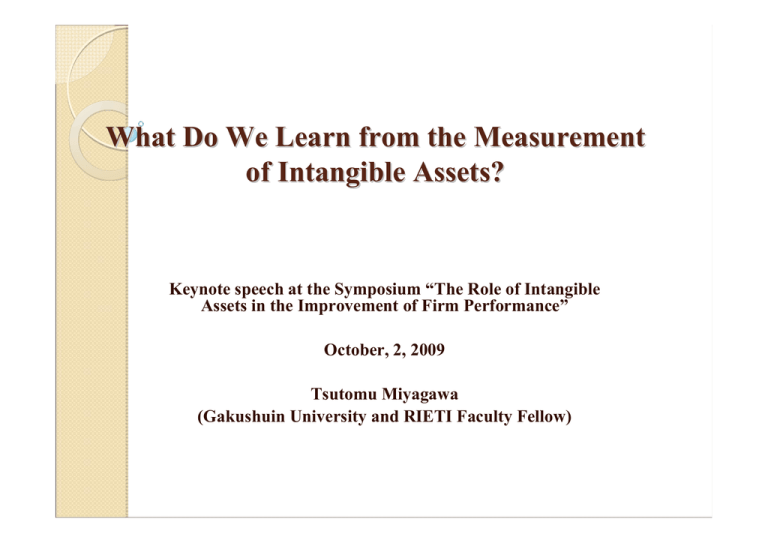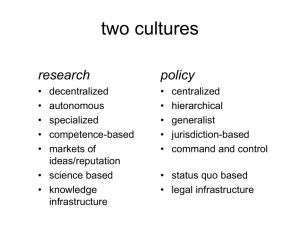What Do We Learn from the Measurement of Intangible Assets?
advertisement

What Do We Learn from the Measurement of Intangible Assets? Keynote speech at the Symposium “The Role of Intangible Assets in the Improvement of Firm Performance” October, 2, 2009 Tsutomu Miyagawa (Gakushuin University and RIETI Faculty Fellow) Contents 1. Why is intangible investment important for the Japanese economy? 2. Measurement of aggregate intangible investment in Japan 3. Intangible investment by industry 4. Measurement in intangible investment at the firm level 5. The role of intangible assets at the macro, industry, and firm levels 1. Why is intangible investment important for the Japanese economy? 1 0.9 0.8 0.7 0.6 0.5 0.4 0.3 Japan/US UK/US 0.2 0.1 0 1970 1972 1974 1976 1978 1980 1982 1984 1986 1988 1990 1992 1994 1996 1998 2000 2002 2004 The convergence of labor productivity in Japan to the US level came to a halt in the mid-1990s. y Growth accounting shows that the cause of this phenomenon is the slowdown in capital deepening and TFP growth in Japan, and the acceleration of TFP growth in the US. y GDP per man-hour input in Japan and the UK in comparison with the US: 1975-2005, based on gross output PPP of 1997 Source: EU KLEMS, March 2008 3 1. Why is intangible investment important for the Japanese economy? The TFP gap between the US and the other developed countries has been explained by the following two factors. (1)Accumulation in IT assets (2)Accumulation in intangible assets, which plays a complementary role in IT assets. Economic Report of the President, 2007:”Only when they made intangible investments to complement their IT investments did productivity growth really take off” y y It seems that Japan, Korea and the continental EU countries did not experience an “IT revolution,” partly because of the stagnation of IT investment. 5 However, the degree of the effects of IT capital on TFP growth is different among firms and among countries (for example the US vis a vis the UK). We examine TFP growth by country and by industry, and find that the TFP gap between the US and Japan is due to the low TFP growth in service industries in Japan. Economists believe that the low TFP growth is likely to be related to accumulation in intangible assets. Contributions of IT Capital Service Input Growth to the Economic Growth (%) 2000-05 Germany Korea 0.34 0.75 Japan 0.41 France 0.50 Italy 0.13 UK 1.23 US 0.85 0.47 0.03 0.25 1.18 0.15 3.78 1.59 0.22 0.19 0.12 0.36 0.06 0.59 0.65 0.03 0.37 0.03 0.07 0.06 0.22 0.69 .Distribution services 0.10 0.63 0.21 0.28 0.07 0.90 0.83 .Finance and business services 1.50 0.79 0.99 2.44 0.34 2.33 0.89 .Personal and social services 0.07 0.45 0.10 0.26 0.12 0.60 0.74 Market economy total .Electrical machinery, post and communication .Manufacturing, excluding electrical .Other goods producing industries Source: EU KLEMS Database March 2008 and KIP Database. 2. Measurement of aggregate intangible investment in Japan We measure the intangible investment in Japan following the approach of Corrado, Hulten, and Sichel (2005, 2006). We estimated the three categories of intangible asset investment using the sources listed below. 1. Computerized information Software and databases → IO tables, Survey on Selected Service Industries, ICT Workplace Survey, etc. 2. Innovative property Scientific and nonscientific R&D, mineral exploitation, copyright and license costs, and other product development, design, and research expenses → Japan Industrial Productivity (JIP) Database (http://www.rieti.go.jp/en/database/JIP2008/index.html), , Survey of Research and Development, etc. 3. Economic competencies Brand equity, firm-specific human capital, and organizational structure → JIP Database, The General Survey on Working Conditions, and Financial Statements Statistics of Corporations by Industry 2. Measurement of aggregate intangible investment in Japan y y y y Annual intangible investment in Japan was 53 trillion yen on average from 2000 to 2005. Computerized information: the ratio of this investment to GDP increased rapidly until 2000. However, it has stagnated since then. Innovative property: innovative property investment (R&D expenses, other product development, etc.) has been the largest among the three categories of intangible investment. The ratio of this investment to GDP was stable from 1998 to 2005. Economic competencies: the ratio of this type of investment to GDP increased until 1990. However, it started to decrease from 2002 because firms cut training expenses and remuneration for executives as part of their restructuring measures in the 2000s. International comparison in intangible investment/GDP ratio Japan Australia Canada France Germany Italy Netherlands Spain UK US All industries (2000-05) Manufacturing (2000-05) Service (2000-05) Market economy (2005-06) All industries ( 2005) Market economy ( 2004) Market economy ( 2004) Market economy ( 2004) All industries ( 2005) Market economy ( 2004) Market economy (2004) Non-farm business (1998-2000) Total investment Computerized information Innovative property Economic competencies 11.1 2.2 6.0 2.9 16.6 2.1 11.5 3.0 9.2 2.4 3.6 3.2 9.6 1.3 3.6 4.7 9.8 1.0 5.0 3.8 8.3 0.9 3.1 4.4 7.1 0.8 3.5 2.9 5.2 0.7 2.3 2.2 8.4 1.4 1.8 5.2 5.2 0.8 2.5 2.0 10.9 1.7 3.2 6.0 1 3.8 1.9 5 .3 6.6 (Source) Barnes and McClue (2008), Corrado, Hulten and Sichel (2009), and Fukao et al (2009) 2. Measurement of aggregate intangible investment in Japan y y y y The ratio of intangible investment to GDP was 11.1%, lower than that for the US estimate by CHS (2009) and larger than that for the UK by Marrano and Haskel (2006). While investment in computerized information and innovative property in Japan was not lower than that in the US and the UK, investment in economic competencies (especially firm-specific human capital and organizational change) was much lower than that in the US and the UK. Moreover, the ratio of intangible investment to tangible investment was much lower than that in the US. While in the US, intangible investment has exceeded tangible investment since the mid-1990s, in Japan, intangible investment is still smaller than tangible investment. % 16 Japan 26 24 Intangible Investment Tangible Investment 14 12 10 1980 1981 1982 1983 1984 1985 1986 1987 1988 1989 1990 1991 1992 1993 1994 1995 1996 1997 1998 1999 2000 2001 2002 2003 18 1980 1981 1982 1983 1984 1985 1986 1987 1988 1989 1990 1991 1992 1993 1994 1995 1996 1997 1998 1999 2000 2001 2002 2003 2004 2004 Intangible and Tangible Investment in Japan and the US % US 26 24 22 22 Intangible Investment 20 20 Tangible Investment 18 16 14 12 10 8 8 6 6 13 2. Measurement of aggregate intangible investment in Japan 1. 2. We examine the contribution of intangible assets to economic growth in Japan by following CHS (2006). The growth accounting results are as follows: The contribution of intangible capital accumulation to labor productivity has declined since 1985. This is because the contribution of intangible assets, as well as the contribution of tangible assets has declined, i.e., the total capital deepening effect has slowed down. Instead, the contribution of MFP growth has rebounded since 1995. Growth accounting with intangibles Growth rate of GDP 1985-90 4.89 (%) 1990-95 1995-2000 2000-05 1.05 1.24 1.50 Growth rate of labor input 0.93 -0.11 -0.52 -0.61 Growth rate of labor productivity 3.96 1.16 1.76 2.11 Contribution of capital deepening 2.66 1.75 1.34 1.17 Contribution of tangible capital Contribution of intangible capital 1.77 0.89 1.25 0.49 0.86 0.47 0.83 0.33 1.30 -0.59 0.43 0.95 Contribution of MFP growth 1) Source: authors' calculations. 2. Measurement of aggregate intangible investment in Japan y y The share of the contribution of intangible capital to labor productivity growth was 16% (2000-05), which is smaller than the share estimated by CHS for the United States (27%). If the contribution of intangible capital to labor productivity growth in Japan were as large as in the United States, then Japanese labor productivity growth since the year 2000 would have been 0.3 percentage points higher than actually recorded. 3. Intangible investment by industry y y y We measure IT related intangible investment by industry using the JIP 2009 Database, because intangible investment in the service sector is smaller than that in the manufacturing sector. Investment in intangible investment remained steady from 1995 to 2005 in most of the machinery industries. On the other hand, intangible investment in the service sector decreased drastically after 1995. 3. Intangible investment by industry y y y The results in growth accounting in the retail industry are contrast to those in the electric parts industry. Intangible assets contribute positively to output growth and TFP growth is positive in the electric parts industry. On the other hand, we find that intangible assets have contributed negatively to output growth and negative TFP growth in the retail industry since 2000. 4. Measurement in intangible investment at firm level y y y We try to measure organizational management and human resource management at the firm level.←(1) Investment in firm-specific resources at the aggregate level depends on customs and institutions of the labor market in each country, (2) Management practices with respect to organizational and human capital are important for productivity improvement in the service industry. Following Bloom and Van Reenen (2007), we conducted interview surveys regarding organizational management and human resource management in Japanese and Korean firms. Based on the results of the surveys, we constructed a measure evaluating the management practices of a firm and examined the effects of management practices on firm performance. 4. Measurement in intangible investment at firm level y y We conducted the interview surveys focusing on four industries in the manufacturing sector (Electric machinery, Information and communication equipment , Motor vehicle , and Precision machinery) and three industries in the service sector (Internet-based services and information services, Media activities, and Retail service). In Japan, we obtained our data from 573 firms. As the total sample was 1086 firms, the response rate in Japan was 53%. In Korea, we obtained the data of 350 firms from a sample of 591 firms (the response rate was 59%). 4. Measurement in intangible investment at firm level y y y We classify our interview questions into two parts: questions related to organizational capital and questions related to human capital. As for organizational capital, high scores suggest that the organization is more transparent and every employee holds the same information with respect to firm performances. As for human capital, high scores suggest more flexible human resource management. Firms making high scores with respect to human capital promote employees who show good performance swiftly, and value improvements in human capital through job training. 4. Measurement in intangible investment at firm level y y y The mean in the distribution of average scores in Japan (2.73) is higher than that in Korea (2.33). The mean in the distribution of average scores in the Japanese retail firms (2.70) hardly differs from that in the total firms. The mean in the distribution of average scores with organizational capital in Japanese retail firms (2.77) is lower than those in firms in other industries. 0 0 .2 .5 D en sity .4 Density 1 .6 .8 1.5 The distributions of management scores in Japanese and Korean firms: the left figure shows the distribution in Japanese firms and the right figure shows the distribution in Korean firms. 1 2 3 Score 4 1 2 3 Score 4 0 0 .2 .5 Density Density .4 1 .6 .8 1.5 The distributions of management scores in Japanese retail firms: one is the distribution of management scores with respect to the total management practices (left figure) and the other is the distribution of management scores with respect to organizational capital. 1 2 3 Score 4 1 2 3 Score 4 4. Measurement in intangible investment at firm level y y The distribution of average scores in small and medium sized firms in Korea are concentrated at a lower level, because average score in human capital in Korean small and medium sized firms are relatively low. The results imply that human resource management in Korean small and medium sized firms is more conservative than those in Japanese firms. 0 0 .2 .2 .4 .4 D ensity .6 Density .6 .8 .8 1 1 The distributions of management scores in Japanese and Korean small and medium sized firms: the left figure shows the distribution in Japanese firms and the right figure shows the distribution in Korean firms. 1 2 3 Score 4 1 2 3 Score 4 4. Measurement in intangible investment at firm level ・ Using management scores, we examine the effects of management practices on firm performance. ・ In Japanese firms, organizational reform improves firm performances, while the average management scores do not affect firm performance. ・ In Korean firms, the first principal factor mainly reflecting human resource management improves firm performances. These effects are particularly significant in the manufacturing sector. The results imply that Korean firms are likely to improve their performance by being more flexible in their human resource management. 5. The role of intangible assets at macro, industry, and firm levels We took a look at the Japanese intangible investment at the macro, industry and firm levels. y The implications of our study are as follows. (1) Macro level: Intangible investment in Japan has stagnated since 2000, although it increased until the mid 1990s. Investment in economic competencies in Japan is lower than that in some developed countries. The increase in intangible investment will work to shrink the gap in labor productivity between Japan and the US. y 5. The role of intangible assets at macro, industry, and firm levels (2) Industry level: In many industries in the Japanese service sector, the accumulation in intangible assets became negative after 1995. For example, we find a negative contribution of intangible assets to output growth and negative TFP growth in the retail industry in the 2000s. (3) Firm level: According to the interview surveys conducted in Japan and Korea, human resource management between Japanese and Korean firms differs greatly. While organizational reform affects firm performances in Japan, improvement in human resource management contributes positively to firm performances in Korea. 5. The role of intangible assets at macro, industry, and firm levels y y In the 1980s, Japanese firms had advantages in in their systems for production and human resource management. These systems were supported by financial institutions. However, these advantages deteriorated after the collapse of the bubble economy. Japan must now reconstruct a new management system by accumulating intangible assets. 5. The role of intangible assets at macro, industry, and firm levels ・How can we improve productivity growth through the accumulation in intangible assets? (1) Reconstruct our job training system. (2) Introduce a new accounting system that takes intangible assets into account. This would make way for banking and insurance firms to recognize intangible assets as collateral for finance. (3) Make efforts to transform the current system in which banks dominate corporate financing to a new financial system in which even small firms can gain access to funds through capital markets.





